
Guest Post by Sara Johnson, Conservation Biologist with the North American Land Trust and Land Trust of North Alabama volunteer
Late Summer 2023 Blevins Gap Pollinator Garden Update
Blevins Gap Nature Preserve is one of the most visited preserves in North Alabama with approximately 11,000 visitors each year. Since road construction on Cecil Ashburn in 2020, the large area to the northwest of the Blevins Gap parking lot has been vacant, filling in with a mix of native and non-native grassland plant species. Throughout this time, it has become a popular and beloved gathering space to view the stunning sunsets over the city of Huntsville. A plan began to develop to transform this open space for mixed-use recreation with a shaded picnic area, benches to rest and enjoy the scenery, and a planted garden to highlight the native plants of our region. In 2021, the Land Trust received financial support from from The Bakken Family with additional support from Evelyn Spaulding and Mike and Patty Lowe to put this plan into action and create a pollinator garden with the goal of educating and encouraging the public to learn more about the incredible native plants that can be found throughout North Alabama. This pollinator garden acts like a microcosm of the flora and fauna found in our biodiverse region and hopefully, will encourage individuals to learn some of their names of the plants that grow here, and the insects and wildlife that depend on them.

A mixture of planted Black-eyed Susan (Rudbeckia hirta) and volunteer Late Boneset (Eupatorium serotinum) – Photo Credit: Sara Johnson
With design and plant selection led by Harvey Cotten, the Master Gardeners of North Alabama, and the Land Trust’s Pollinator Garden committee, a vision of the beds began to take shape. Volunteers sorted through the plant lists of multiple nurseries to find plants that could cope with the harsh conditions at Blevins Gap (i.e. strong winds, dry soils, and heavy use) and also provide beauty to the community and benefit to wildlife; especially native insects and pollinators. Plans aimed to include a variety of native trees, shrubs, and herbaceous species that are both commercially available and can grow well in the home garden.
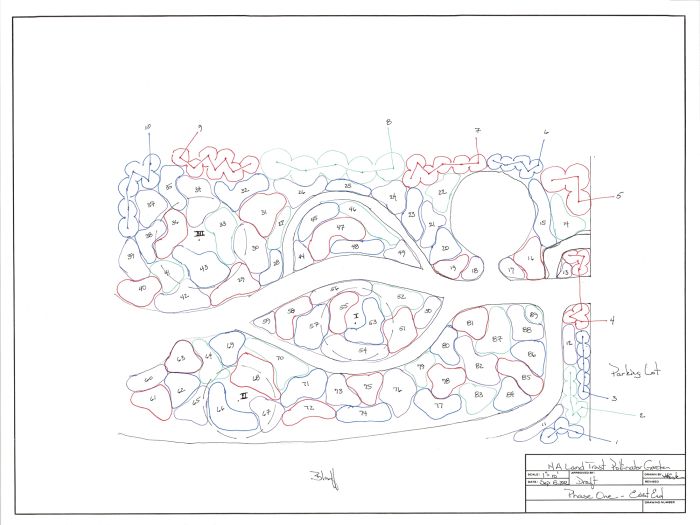
Original Pollinator Garden Design by Harvey Cotten
Plants were purchased from two regional nurseries: Camp Creek Natives in Mississippi and Overhill Gardens in Tennessee. Curious why we had to look out of state for native plants? Check out our Native Plants for North Alabama Gardens blog post. Volunteer Joe Ruf drove to retrieve our plants and Soozi and Dan Pline stored and protected them in their yard until our first planting event. The original goal was to get plants in the ground in early December of 2022 after the plants arrived, but nature had other plans. A round of severe weather dumped a deluge of rain creating wet and soggy conditions at the prepared pollinator beds. Then, an arctic blast of freezing and below freezing temps swept through the region on Christmas weekend. We did not know how the plants would survive, but fortunately, volunteers Soozi and Dan kept them safe and under cover until our rescheduled planting event in early January 2023. Despite the misty and cloudy weather, 40 incredible volunteers came out to help and collectively, we planted over 650 plants! Still, we were unsure how the plants, mainly dormant, would survive the rest of winter and early spring. We crossed our fingers and hoped for the best.
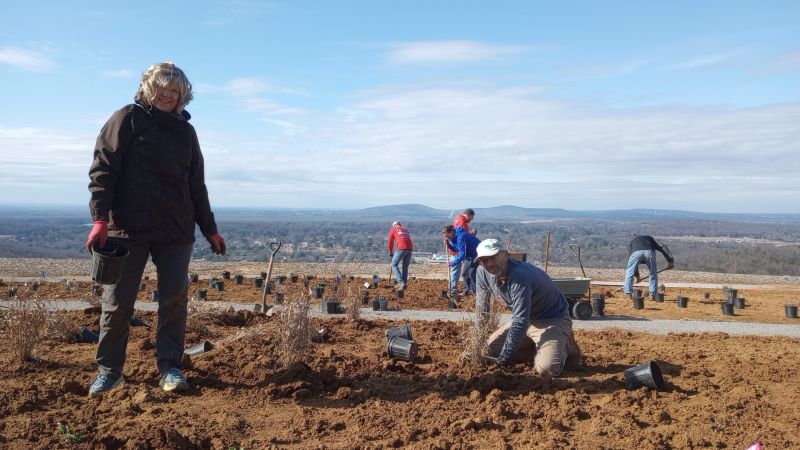
Our first planting event in January 2023. – Photo Credit: Sara Johnson
Early on, it became apparent that some plants may have not made it through the extreme fluctuations over the winter, but many plants persisted. So in mid-April, we began our regular volunteer events to ensure consistent eyes on the garden to maintain the plants, pull encroaching weeds (primarily non-native grasses and other weedy plants), keep beds regularly mulched, and mainly, keep the plants watered during hard times. A second planting event was in place to finish planting leftover plants and add layers of pine straw mulch, however, a severe weather event pushed our April 1st planting to May 6th. Fortunately, this event was a success, and Zone 9 of the pollinator garden was completed. Since then, our core volunteer group has been meeting regularly to reassess and reevaluate how to best manage and maintain the garden.
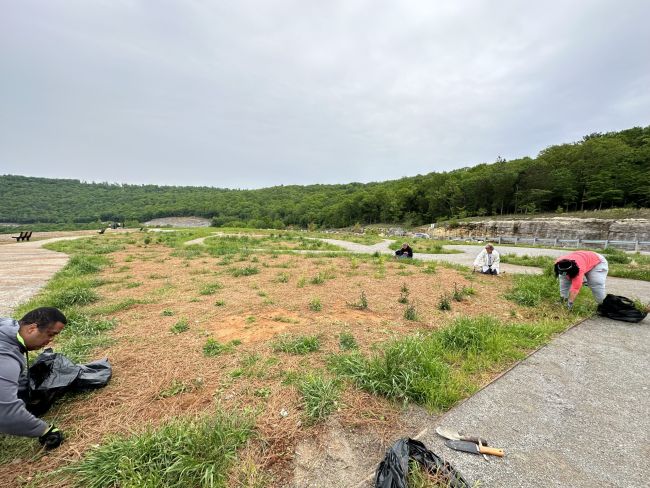
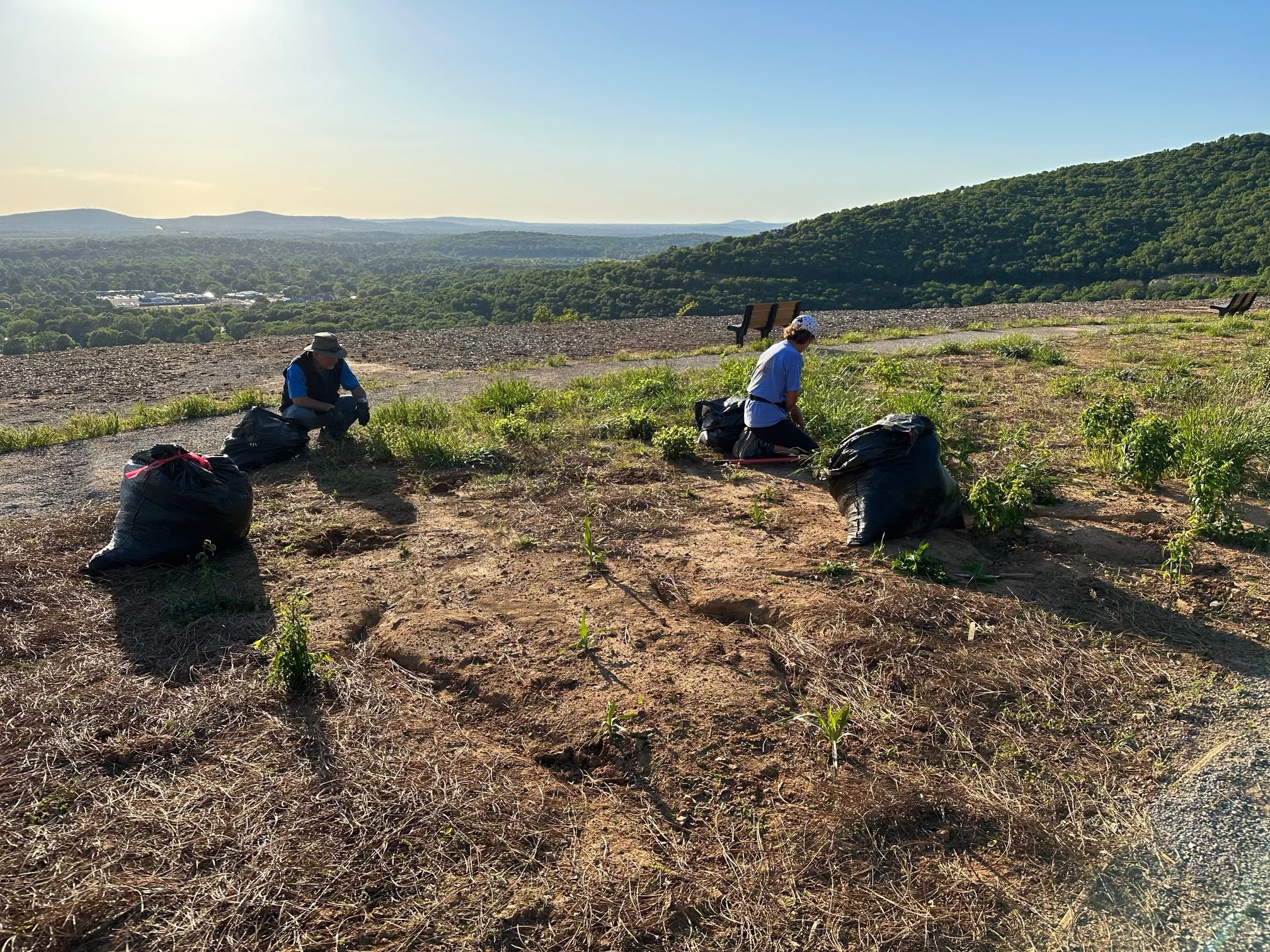
Volunteers with a view during an April weeding event. – Photo Credit: Sara Johnson
Gardening is always a hopeful endeavor, and importantly, also a learning experience. Between then and now, the gardens have experienced the full range of elements. Between vandalism (i.e. pulling plants or tags and trampling) and extreme weather, the pollinator garden has really gone through it this year. Severe rain caused flooding and soil erosion, while extreme heat and drought caused weeds to thrive and native plants to buckle under the stress. Watering became a challenge with no local water on-site forcing staff and volunteers to think creatively. We rented water cisterns and brought backpack sprayers to get through the worst of the heat. We have learned a lot, and are still learning how best to convert an empty space into a thriving ecosystem for native species. As with many conservation challenges, these obstacles are no different when building a native garden. We only hope that with persistence and advocacy, the challenges we face to battle a changing climate, invasive species, and encourage the production of native seed stock for our plantings, improves and becomes easier over time.

Pollinator Garden at sunset – Photo Credit: Patti Lowe
Thanks to the continued hard work of our volunteers, we have flagged and begun tagging the remaining plants with their names. Many of the plants that have survived the challenging conditions of the exposed garden are blooming and already attracting wildlife. Now it is just a matter of recruiting help to face some of the challenges of weeds and encroachment. Our greatest hope is that we can apply what we have learned to future gardens on other Land Trust nature preserves. Through the process, we have made sure to document our journey and aim to share what we have learned with signage and helpful tips to starting your own pollinator garden. Soon, we hope to share an interactive StoryMap with photos and information for the plants in the garden to help people learn and identify native plants and learn more about their ecology.
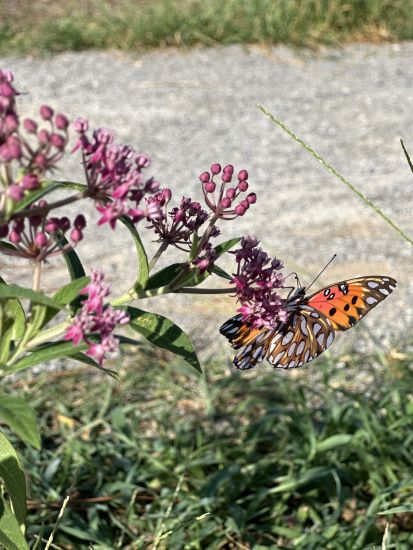
Gulf fritillary butterfly feeding on the nectar of a Swamp Milkweed (Asclepias incarnata). – Photo Credit: Sara Johnson
While this endeavor has come with challenges, we feel very proud of all of the individuals who came together to keep these plants thriving and growing, and we see a bright future for the pollinator garden. People will be able to use this space for education, relaxation, and a respite from the city for generations to come. Please get in touch if you would like to volunteer and check our event calendar for upcoming opportunities! To learn more about how to incorporate native plants into your own backyard, check out our recent Native Plants for North Alabama Gardens blog post and sign up to join us for a Members-only Native Plant Workshop on Sunday, October 1 at the Blevins Gap Pollinator Garden.
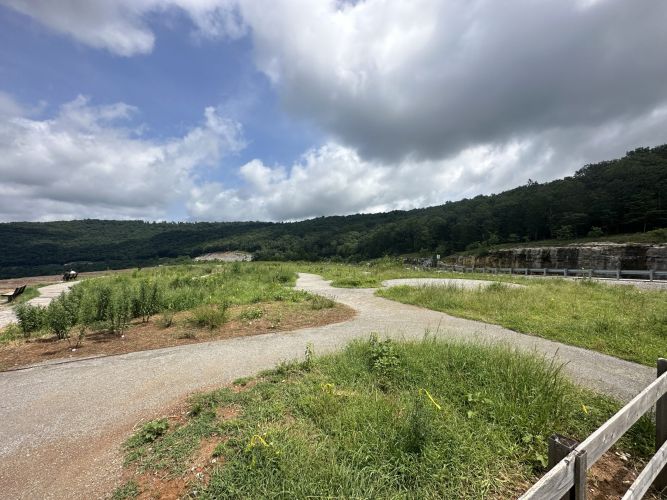
Pollinator Garden in July 2023 – Photo Credit: Sara Johnson